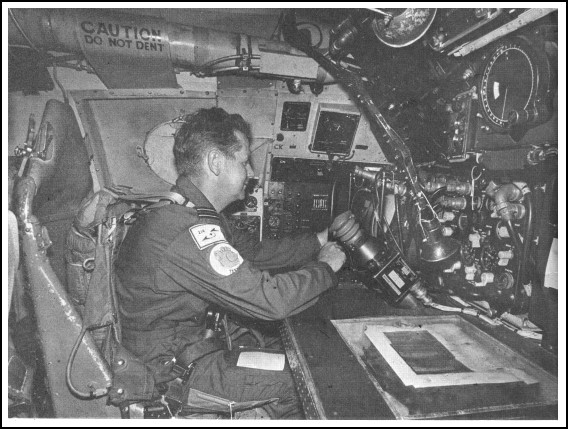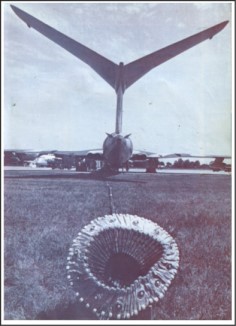



During several scheduled aircraft displays at Offutt, I (Lt Col W.P.Hurn Editor Combat Crew) got a chance to photograph the RAF counterpart of our KC- 135 the Handley Page Victor. and talk to some of the crews. I thought you guys in S.A.C. that fly tankers, or refuel behind them might like to take a look at their hardware and read a few words about flying in the RAF.

The Victor tankers, which are converted Victor B Mk 1A bombers are powered by four Bristol Siddeley Sapphire turbojet engines with 11,000 pounds of thrust each. Two of these are mounted in each wing root behind a single intake, and at first glance it looks like a twin engine aircraft from the front. All four tail pipes are clearly visible from the rear. All refuelling in the RAF is probe and drogue. Three big reels each with 85 feet of hose are in the aft fuselage and in pods under the wings. The centre station can transfer up to 4000 pounds per minute and can be used for any type of receiver.

Flight Lieutenant Geoff Armitage at the refuelling operator's station. Refuelling controls are on his left and the radar, also his job, is in front of him. Plotting officer's table is in the foreground, That refuelling probe above the cockpit is not just for show. All RAF tanker crews are receiver qualified.
The wing stations are for use by fighter type receivers only can transfer about 1200 pounds per minute each, and may be used simultaneously. Wing span of the tanker does not provide room to use wing and centre stations at the same time, however. The Victor is used to refuel the Vulcan bomber, fighters, and other Victors. Refuelling of the Vulcan has been reduced in recent years primarily because the Vulcan has adequate unrefuelled range for most missions. Refuelling fighters is the Victor's primary business and like us, the RAF conducts lots of buddy fighter deployments. Unlike us, the RAF frequently uses tankers for refuelling other tankers to provide increased range or offload capability and all operational RAF tanker crews are receiver qualified. The Victor tanker has a five man crew; pilot, Co pilot. refuelling operator, plotting officer, and air electronics officer. The pilots' jobs are about the same as for our tankers except that alternator and hydraulic systems, pilot operated on the KC135 are the responsibility of the air electronics officer (AEO) on the Victor. The Victor refuelling operator (Nav Rad) is a qualified navigator and also functions as radar operator. The bombing radar is still in stalled in the Victor and is used for navigation and air refuelling rendezvous. Most functions of the KC- 135 navigator are filled by the plotting officer (Nav Plotter) except for the radar function just described. The Victor crew cannot see receiver aircraft directly but can scan one receiver at a time through a periscope type optical device. Hookup is strictly up to the receiver pilot, except for the tanker pilot maintaining a stable platform. The drogues are on long hoses and reels automatically take up hose if the receiver closes on the tanker - therefore there is no S-bend in the hose as we know it in KC-135 drogue refuelling. The Victor looks like a good machine to fly. It has all boosted controls and lots of wing for good take off and high altitude performance. The pilots have ejection seats but the escape system for other crew members is "down the chute," very similar to ours. It also has a drag chute - nice for stopping on those wet runways. All in all, a great bird flown by a great bunch of guys. Right: Flight Lieutenant John Brown at the controls of the Victor, He's wearing the soft "radio helmet for oxygen and communications. A hard hat shell must be worn over this during takeoff, landing, and air refuelling. The Mk II Victor, a conversion by Hawker Siddeley, with external wing tanks and 20,000 pound thrust Rolls Royce Conway engines, is even better and it's already being flown by the RAF. Lower Right: A Handley Page advertisement (depicting the earlier Bomber Variant Of The Victor) (Thanks to Dave Robinson for this article. |
   |